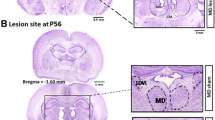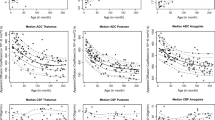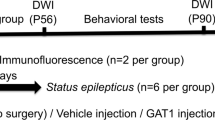Abstract
Rationale and objectives
In schizophrenia research, most of the functional imaging studies have been performed in psychotic patients, but little is known about brain areas involved in the expression of psychotic-like symptoms in animal models. The objective of this study was to visualize and compare brain activity abnormalities in a neurodevelopmental and a pharmacological animal model of schizophrenia.
Methods
Blood perfusion of specific brain areas, taken as indirect measure of brain activity, was investigated in adult rats following either neonatal ventral hippocampal lesion or acute administration of phencyclidine. Quantitative perfusion magnetic resonance imaging was performed on five frontal brain slices using the continuous arterial spin labeling technique. The mean perfusion was calculated in several brain structures, which were identified on anatomical images.
Results
Lesioned animals exhibiting deficits in prepulse inhibition of the startle reflex showed a significant blood perfusion increase in the nucleus accumbens, basolateral amygdala, ventral pallidum, entorhinal–piriform cortex, orbital prefrontal cortex, and in the bed nucleus of the stria terminalis, and a decrease of perfusion in the temporal cortex. Similar effects were seen following acute phencyclidine administration in naïve animals.
Conclusion
Our data point out specific cortical and subcortical brain areas involved in the development of psychotic-like symptoms in two different animal models of schizophrenia. The observed brain activity abnormalities are reminiscent of classical neuroimaging findings described in schizophrenic patients.








Similar content being viewed by others
References
Al-Amin HA, Weinberger DR, Lipska BK (2000) Exaggerated MK-801-induced motor hyperactivity in rats with the neonatal lesion of the ventral hippocampus. Behav Pharmacol 11:269–278
Andreasen NC, O’Leary DS, Flaum M, Nopoulos P, Watkins GL, Ponto LLB, Hichwa RD (1997) Hypofrontality in schizophrenia: distributed dysfunctional circuits in neuroleptic-naïve patients. Lancet 349:1730–1734
Aslop DC, Detre JA (1996) Reduced transit-time sensitivity in noninvasive magnetic resonance imaging of human cerebral blood flow. J Cereb Blood Flow Metab 16:1236–1249
Barbier EL, Lamalle L, Decorps M (2001) Methodology of brain perfusion imaging. J Magn Reson Imaging 13(4):496–520
Barch DM, Carter CS, Braver TS, Sabb FW, MacDonald A, Noll DC, Cohen JD (2001) Selective deficits in prefrontal cortex function in medication-naïve patients with schizophrenia. Arch Gen Psychiatry 58:280–288
Benes FM, Berretta S (2000) Amygdalo-entorhinal inputs to the hippocampal formation in relation to schizophrenia. Ann NY Acad Sci 911:293–304
Bertolino A, Saunders RC, Mattay VS, Bachevalier J, Frank JA, Weinberger DR (1997) Altered development of prefrontal neurons in rhesus monkeys with neonatal mesial temporo-limbic lesions: a proton magnetic resonance spectroscopic imaging study. Cereb Cortex 7:740–748
Bertolino A, Roffman JL, Lipska BK, van Gelderen P, Olson A, Weinberger DR (2002) Reduced N-acetylaspartate in prefrontal cortex of adult rats with neonatal hippocampal damage. Cereb Cortex 12:983–990
Braus DF, Brassen S, Weimer E, Tost H (2003) Functional magnetic resonance imaging of psychopharmacological brain effects: an update. Fortschr Neurol Psychiatr 71:72–83
Bunney WE, Bunney BG (2000) Evidence for a compromised dorsolateral prefrontal cortical parallel circuit in schizophrenia. Brain Res Rev 31:138–146
Chambers RA, Moore JM, McEvoy JP, Levin ED (1996) Cognitive effects of neonatal hippocampal lesions in rat model of schizophrenia. Neuropsychopharmacology 15:587–594
Crespo-Facorro B, Paradiso S, Andreasen NC, O’Leary DS, Watkins GL, Ponto LLB, Hichwa RD (2001) Neural mechanisms of anhedonia in schizophrenia. JAMA 286:427–435
Curtis VA, Bullmore ET, Morris RG, Brammer MJ, Williams SC, Simmons A, Sharma T, Murray RM, McGuire PK (1999) Attenuated frontal activation in schizophrenia may be task dependent. Schizophr Res 37:35–44
Deichmann R, Hahn D, Haase A (1999) Fast T1 Mapping on a whole-body scanner. Magn Reson Med 42:206–209
Detre DJ, Wang J (2002) Technical aspects and utility of fMRI using BOLD and ASL. Magn Reson Med 48:242–254
Fuster JM (1997) The prefrontal cortex: anatomy, physiology and neuropsychology of the frontal lobe, 3rd edn. Raven-Lippincott, Philadelphia
Goff DC, Tsai G, Levitt J, Amico E, Manoach D, Schoenfeld DA, Hayden DL, McCarley R, Coyle JT (1999) A placebo-controlled trial of d-cycloserine added to conventional neuroleptics in patients with schizophrenia. Arch Gen Psychiatry 56:21–27
Groenewegen HJ, Berendse HW (1994) The specificity of the ‘nonspecific’ midline and intralaminar thalamic nuclei. Trends Neurosci 17:52–57
Haase A, Frahm J, Matthaei D, Hänicke W, Merboldt KD (1986) FLASH imaging. Rapid NMR imaging using low flip-angle pulses. J Magn Reson 67:258–266
Harrison PJ (1999) The neuropathology of schizophrenia: a critical review of the data and their interpretation. Brain 122:593–624
Heckers S (2001) Neuroimaging studies of the hippocampus in schizophrenia. Hippocampus 11:520–528
Heeger DJ, Ress D (2002) What does fMRI tell us about neuronal activity? Nat Rev Neurosci 3:142–151
Heinz A, Romero B, Gallinat J, Juckel G, Weinberger DR (2003) Molecular brain imaging and the neurobiology and genetics of schizophrenia. Pharmacopsychiatry 36(Suppl 3):S152–S175
Heresco-Levy U, Javitt DC (2004) Comparative effects of glycine and d-cycloserine on persistent negative symptoms in schizophrenia: a retrospective analysis. Schizophr Res 66:89–96
Javitt DC, Silipo G, Cienfuegos A, Shelley AM, Bark N, Park M, Lindenmayer JP, Suckow R, Zukin SR (2001) Adjunctive high-dose glycine in the treatment of schizophrenia. Int J Neuropsychopharmacol 4:385–391
Javitt DC, Balla A, Burch S, Suckow R, Xie S, Sershen H (2004) Reversal of phencyclidine-induced dopaminergic dysregulation by N-methyl-d-aspartate receptor glycine-site agonists. Neuropsychopharmacology 29:300–307
Jentsch JD, Taylor JR, Elsworth JD, Redmond DE Jr, Roth RH (1999) Altered frontal cortical dopaminergic transmission in monkeys after subchronic phencyclidine exposure: involvement in frontostriatal cognitive deficits. Neuroscience 90:823–832
Kasai K, Iwanami A, Yamasue H, Kuroki N, Nagakome K, Fukuda M (2002) Neuroanatomy and neurophysiology in schizophrenia. Neurosci Res 43:93–110
Krystal JH, Karper LP, Seibyl JP, Freeman GK, Delaney R, Bremner JD, Heninger GR, Bowers MB, Charney DS (1994) Subanesthetic effects of the noncompetitive NMDA antagonist ketamine in humans. Psychotomimetic, perceptual, cognitive, and neuroendocrine responses. Arch Gen Psychiatry 51:199–214
Lahti AC, Koffel B, Laporte D, Tamminga CA (1994) Subanesthetic doses of ketamine stimulate psychosis in schizophrenia. Neuropsychopharmacology 13:9–19
Le Bihan D (1996) Functional MRI of the brain principles, applications and limitations. J Neuroradiol 23:1–5
Le Pen G, Grottick AJ, Higgins GA, Martin JR, Jenck F, Moreau J-L (2000) Spatial and associative learning deficits induced by neonatal excitotoxic hippocamapl damage in rats: further evaluation of an animal model of schizophrenia. Behav Pharmacol 11:257–268
Le Pen G, Gaudet L, Mortas P, Mory R, Moreau JL (2002) Deficits in reward sensitivity in a neurodevelopmental rat model of schizophrenia. Psychopharmacology 161:434–441
Leslie RA, James MF (2000) Pharmacological magnetic resonance imaging: a new application for functional MRI. TIPS 21:314–318
Lillrank SM, Lipska BK, Kolachana BS, Weinberger DR (1999) Attenuated extracellular dopamine levels after stress and amphetamine in the nucleus accumbens of rats with neonatal ventral hippocampal damage. J Neural Transm 106:183–196
Lipska BK, Weinberger DR (2000) To model a psychiatric disorder in animals: schizophrenia as a reality test. Neuropsychopharmacology 23:223–239
Lipska BK, Jaskiw GE, Weinberger DR (1993) Postpubertal emergence of hyperresponsiveness to stress and to amphetamine after neonatal excitotoxic hippocampal damage: a potential animal model of schizophrenia. Neuropsychopharmacology 9:67–75
Lipska BK, Chrapusta SJ, Egan MF, Weinberger DR (1995a) Neonatal excitotoxic ventral hippocampal damage alters dopamine response to mild repeated stress and to chronic haloperidol. Synapse 20:125–130
Lipska BK, Swerdlow NR, Geyer MA, Jaskiw GE, Braff DL, Weinberger DR (1995b) Neonatal excitotoxic hippocampal damage in rats causes post-pubertal changes in prepulse inhibition of startle and its disruption by apomorphine. Psychopharmacology 122:35–43
Lukasik VM, Gillies RJ (2003) Animal anaesthesia for in vivo magnetic resonance. NMR Biomed 16(8):459–467
Magistretti PJ, Pellerin L (1999) Cellular mechanisms of brain energy metabolism and their relevance to functional brain imaging. Philos Trans R Soc Lond, B Biol Sci 354:1155–1163
Manoach DS, Gollub RL, Benson ES, Searl MM, Goff DC, Halpern E, Saper CB, Rauch SL (2000) Schizophrenic subjects show aberrant fMRI activation of dorsolateral prefrontal cortex and basal ganglia during working memory performance. Biol Psychiatry 48:99–109
Meyer-Lindenberg A, Miletich RS, Kohn PD, Esposito G, Carson RE, Quarantelli M, Weinberger DR, Faith Berman K (2002) Reduced prefrontal activity predicts exaggerated striatal dopaminergic function in schizophrenia. Nat Neurosci 5:267–271
Niznikiewicz MA, Kubicki M, Shenton ME (2003) Recent structural and functional imaging findings in schizophrenia. Curr Opin Psychiatry 16:123–147
O’Donnell P, Lewis BL, Weinberger DR, Lipska BK (2002) Neonatal hippocampal damage alters electrophysiological properties of prefrontal cortical neurons in adult rats. Cereb Cortex 12:975–982
Ogawa S, Lee TM, Kay AR, Tank DW (1990) Brain magnetic resonance imaging with contrast dependent on blood oxygenation. Proc Natl Acad Sci U S A 87:9868–9872
Paxinos G, Watson C (1986) The rats brain in stereotaxic coordinates, 2nd edn. Academic Press, New York
Pearlson GD (2000) Neurobiology of schizophrenia. Ann Neurol 48:556–566
Rund BR, Borg NE (1999) Cognitive deficits and cognitive training in schizophrenic patients: a review. Acta Psychiatr Scand 100:85–95
Russell TA, Rubia K, Bullmore ET, Soni W, Suckling J, Brammer MJ, Simmons A, Williams SC, Sharma T (2000) Exploring the social brain in schizophrenia: left prefrontal underactivation during mental state attribution. Am J Psychiatry 157:2040–2042
Salmeron BJ, Stein EA (2002) Pharmacological applications of magnetic resonance imaging. Psychopharmacol Bull 36:120–129
Sams-Dodd F (1999) Phencyclidine in the social interaction test: an animal model of schizophrenia with face and predictive validity. Rev Neurosci 10:59–90
Schultz SK, Andreasen NC (1999) Schizophrenia. Lancet 353:1425–1430
Shenton ME, Dickey CC, Frumin M, McCarley RW (2001) A review of MRI findings in schizophrenia. Schizophr Res 49:1–52
Silva AC, Kim S-G (2003) Perfusion-based functional magnetic resonance imaging. Concepts Magn Reson 16A:16–27
Silva AC, Zhang W, Williams DS, Koretsky (1995) Multi-slice MRI of rat brain perfusion during amphetamine stimulation using arterial spin labelling. MRM 33:209–214
Thompson PM, Vidal C, Giedd JN (2001) Mapping adolescent brain change reveals dynamic wave of accelerated gray matter loss in very early schizophrenia. Proc Natl Acad Sci U S A 98:11651–11655
Tsacopoulos M, Magistretti PJ (1996) Metabolic coupling between glia and neurons. J Neurosci 16(3):877–885
Turner R, Jones T (2003) Techniques for imaging neuroscience. Br Med Bull 65:3–20
Uehara T, Tanii Y, Sumiyoshi T, Kurachi M (2000) Neonatal lesions of the left entorhinal cortex affect dopamine metabolism in the rat brain. Brain Res 860:77–86
Velakoulis D, Pantelis C (1996) What have we learned from functional imaging studies in schizophrenia? The role of frontal, striatal and temporal areas. Aust N Z J Psychiatry 30:195–209
Weinberger DR, Berman KF, Zec RF (1986) Physiologic dysfunction of dorsolateral prefrontal cortex in schizophrenia. I. Regional cerebral blood flow evidence. Arch Gen Psychiatry 43:114–124
Williams DS, Detre JA, Leigh JS, Koretsky AP (1992) Magnetic resonance imaging of perfusion using spin inversion of arterial water. Proc Natl Acad Sci U S A 89:212–216
Witter MP, Wouterlood FG, Naber PA, van Haeften T (2000) Anatomical organization of the parahippocampal–hippocampal network. Ann NY Acad Sci U S A 911:1–24
Woodruff PW, Wright IC, Bullmore ET, Brammer M, Howard RJ, Williams SC, Shapleske J, Rossell S, David AS, McGuire PK, Murray (1997) Auditory hallucinations and the temporal cortical response to speech in schizophrenia: a functional magnetic resonance imaging study. Am J Psychiatry 154:1676–1682
Wolterink G, Daenen L, Dubbeldam S, Gerrists M, van Rijn R, Kruse C, van der Heijden J, van Ree J (2001) Early amygdala damage in the rat as a model for neurodevelopmental psychopathological disorders. Eur Neuropsychopharmacol 11:51–59
Author information
Authors and Affiliations
Corresponding author
Rights and permissions
About this article
Cite this article
Risterucci, C., Jeanneau, K., Schöppenthau, S. et al. Functional magnetic resonance imaging reveals similar brain activity changes in two different animal models of schizophrenia. Psychopharmacology 180, 724–734 (2005). https://doi.org/10.1007/s00213-005-2204-8
Received:
Accepted:
Published:
Issue Date:
DOI: https://doi.org/10.1007/s00213-005-2204-8




